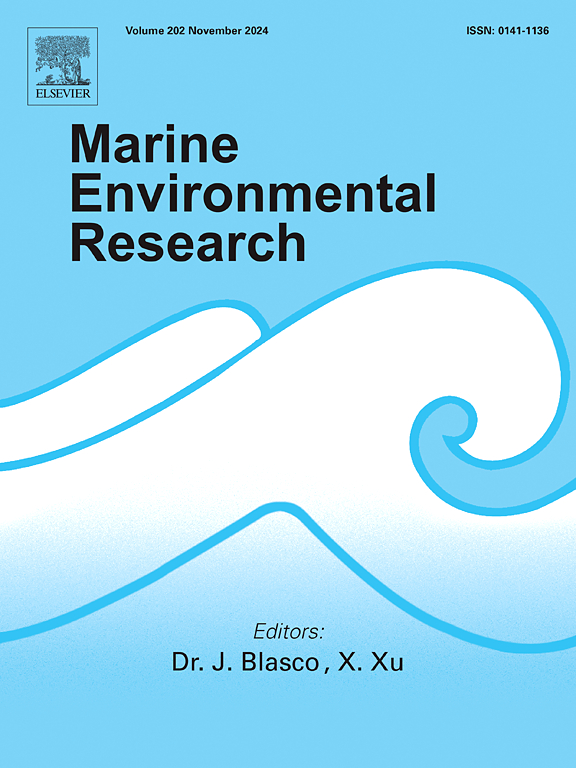突尼斯泻湖的兰花对锌暴露的组织病理和生理反应。
IF 3.2
3区 环境科学与生态学
Q2 ENVIRONMENTAL SCIENCES
引用次数: 0
摘要
比塞特泻湖是一个高产的沿海生态系统,但它面临着人类活动和锌暴露的持续压力。本研究比较了从泻湖岸边采集的三种管弦乐队(管弦乐队,蒙塔吉管弦乐队和地中海管弦乐队)Zn的生物积累。将个体暴露于三种不同锌浓度的污染土壤中,评估其生物和生理反应。用火焰原子发射光谱法测定人体锌浓度。结果显示,接触第二周死亡率显著增加,同时不同物种之间的体重差异也显著不同。地中海稻对锌暴露表现出更大的弹性。在Orchestia种中锌的积累量明显高于周围沉积物,这三种都是锌的富集者。此外,锌污染的底物引起片脚类动物肝胰腺的结构变化,肝胰腺被认为是有效的储存器官,在最高锌浓度下发生最明显的变化。在O. gammarellus中,超微结构变化包括不同形状和大小的脂质颗粒,而O. montagui和O. mediterranea显示细胞边界破坏和线粒体肿胀。本研究强调了兰花对锌污染的敏感性,证实了它们作为沿海环境金属污染生物指标的潜力。本文章由计算机程序翻译,如有差异,请以英文原文为准。
Histopathological and physiological response to zinc exposure in Orchestia species from a Tunisian lagoon
The Bizerte lagoon is a highly productive coastal ecosystem, yet it faces constant pressure from human activities and exposure to Zinc. This study compared Zn bioaccumulation in three Orchestia species (Orchestia gammarellus, Orchestia montagui, and Orchestia mediterranea) collected from the lagoon's banks. Individuals were exposed to contaminated soil with three different zinc concentrations, and their biological and physiological responses were assessed. Body zinc concentrations were measured using flame atomic emission spectrometry. Results showed a significant increase in mortality by the second week of exposure, alongside notable differences in body mass variations between species. O. mediterranea exhibited greater resilience to zinc exposure. Zinc accumulation in the Orchestia species was considerably higher than in the surrounding sediment, classifying all three species as macroconcentrators of zinc. Additionally, zinc-contaminated substrates induced structural changes in the amphipods' hepatopancreas, considered as the efficient storage organ, with the most pronounced alterations occurring at the highest zinc concentrations. In O. gammarellus, ultrastructural changes included lipid granules of varying shapes and sizes, while O. montagui and O. mediterranea displayed disrupted cell borders and swollen mitochondria.
This study highlights the sensitivity of Orchestia species to zinc contamination, confirming their potential as bioindicators of metal pollution in coastal environments.
求助全文
通过发布文献求助,成功后即可免费获取论文全文。
去求助
来源期刊

Marine environmental research
环境科学-毒理学
CiteScore
5.90
自引率
3.00%
发文量
217
审稿时长
46 days
期刊介绍:
Marine Environmental Research publishes original research papers on chemical, physical, and biological interactions in the oceans and coastal waters. The journal serves as a forum for new information on biology, chemistry, and toxicology and syntheses that advance understanding of marine environmental processes.
Submission of multidisciplinary studies is encouraged. Studies that utilize experimental approaches to clarify the roles of anthropogenic and natural causes of changes in marine ecosystems are especially welcome, as are those studies that represent new developments of a theoretical or conceptual aspect of marine science. All papers published in this journal are reviewed by qualified peers prior to acceptance and publication. Examples of topics considered to be appropriate for the journal include, but are not limited to, the following:
– The extent, persistence, and consequences of change and the recovery from such change in natural marine systems
– The biochemical, physiological, and ecological consequences of contaminants to marine organisms and ecosystems
– The biogeochemistry of naturally occurring and anthropogenic substances
– Models that describe and predict the above processes
– Monitoring studies, to the extent that their results provide new information on functional processes
– Methodological papers describing improved quantitative techniques for the marine sciences.
 求助内容:
求助内容: 应助结果提醒方式:
应助结果提醒方式:


